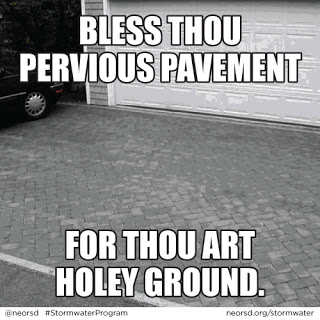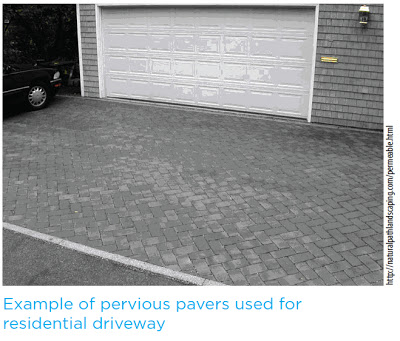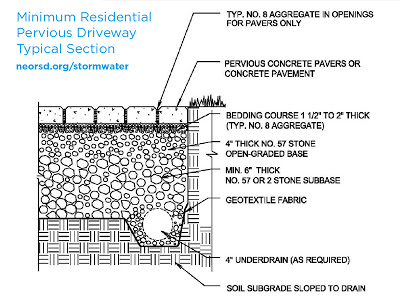
STORMWATER: Houses of the holey? Pervious pavement, other options might be right for your home.
Posted by Jared Shepherd
- 5694 Views
- April 2nd, 2013
- in Miscellaneous
- No Comments
When it comes to reducing runoff, you might want to consider a hole new direction.
Customers in our service area are getting their first look at their property’s stormwater charges, and we’ve received many calls from customers wondering how they can reduce their fees.
It all comes down to reducing stormwater runoff on your property. And if you are looking to make property improvements this spring, stormwater-control measures—rain barrels, rain gardens, filter strips, or reduction of impervious surface—may be worth considering. Today’s topic: Pervious pavement.
Pervious pavements are designed to allow percolation or infiltration of stormwater through tiny holes or separations in the surface into the soil below where the water is naturally filtered and pollutants are removed.
Why consider it? Because our program fee is based on the area of impervious surface on a customer’s property (hard surfaces contribute to regional stream problems associated with runoff), replacing impervious surface with pervious surface reduces runoff as a means of managing stormwater. The credit can help you reduce your fee and save you money in the long run.
Pervious pavement may include paving blocks, grid pavers, pervious concrete, or pervious asphalt. It is recommended that a qualified installer with knowledge in hydrology and hydraulics be consulted for applications using pervious pavement to ensure desired results. This PDF fact sheet provides an overview of construction guidelines and research to date and is not meant to replace the services of experienced, professional installers.
How to receive NEORSD stormwater fee credits for pervious pavement
To obtain an individual residential stormwater fee property credit for pervious pavements, the following criteria must be met:
- It must be installed for the purpose of runoff infiltration.
- The area area of pervious pavement is at least 1,000 sq. ft.
- The pavement or pavers can be used on slopes no greater than 4%.
- The stone reservoir underneath the pavement type must be at least 10 inches deep at all points.
- The installation must meet your local building and zoning standards for driveway installations.
Proper maintenance of your pervious pavement
- Ensure pervious pavement system is draining, and there are not visible signs of standing water on surface.
- Remove accumulated salt on surface during winter months.
- Vacuum as necessary to remove sediment accumulation and organic debris on the pavement surface.
- Remove accumulated leaves and debris from pavement surface in the fall.
What questions do you have?




